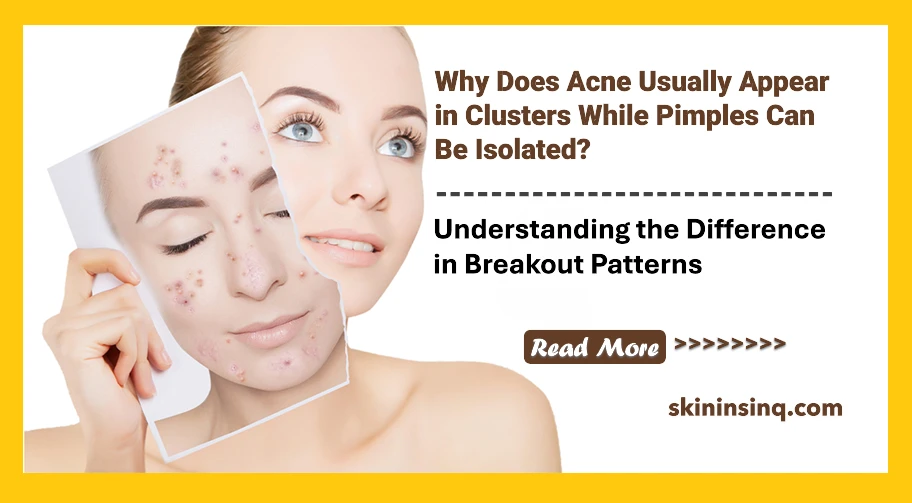Why Does Acne Usually Appear in Clusters While Pimples Can Be Isolated? Understanding the Difference in Breakout Patterns
Why Does Acne Usually Appear in Clusters While Pimples Can Be Isolated? Understanding the Difference in Breakout Patterns
Breakouts are a common skin issue, but not all blemishes are created equal. Some people notice a single, occasional pimple, while others experience clusters of spots that form in specific areas of the face or body. This leads to an important question: why does acne often appear in groups, while pimples can sometimes show up alone? Understanding the biological and environmental differences behind these breakout patterns can help you better manage your skin.
What Is Acne?
Acne is a chronic skin condition involving blocked hair follicles and oil (sebaceous) glands. It commonly manifests as blackheads, whiteheads, papules, pustules, cysts, or nodules. Acne is often influenced by internal factors such as hormones, genetics, and sebum (oil) production. It typically appears in clusters, especially in areas with a high concentration of oil glands like the forehead, cheeks, chin, shoulders, and back.
Why Acne Appears in Clusters
1. Overactive Oil Glands:
Acne-prone skin tends to produce excess sebum, especially during puberty or hormonal shifts. This oil, combined with dead skin cells, can clog multiple pores in the same region, resulting in clusters of breakouts.
2. Inflammation Spread:
Once a pore becomes inflamed, the surrounding tissue may also become irritated. This can lead to nearby pores reacting in the same way, causing a group of inflamed bumps or pustules in a single area.
3. Bacterial Proliferation:
The skin bacterium Cutibacterium acnes (formerly Propionibacterium acnes) thrives in clogged pores. When multiple pores in an oil-rich area become blocked, bacteria can multiply and spread easily, triggering adjacent breakouts.
4. Hormonal Activity:
Hormonal acne often presents as deep, painful clusters of pimples in the lower face, jawline, and neck, due to consistent internal stimulation of the sebaceous glands.
Why Pimples Can Be Isolated
On the other hand, an isolated pimple is usually a temporary skin reaction, not part of a widespread acne condition. These may result from:
-
Clogged pores due to a specific cause, like sweating, touching the face, or applying pore-clogging products.
-
External irritants, such as dirty pillowcases, tight clothing, or makeup.
-
Minor hormonal fluctuations, where only one pore reacts.
-
Localized inflammation, perhaps from an ingrown hair or insect bite, that mimics the appearance of a pimple.
Isolated pimples are often short-lived and do not recur frequently unless the same trigger is repeated.
Managing Clusters vs. Isolated Pimples
-
For acne clusters, consistent skincare with salicylic acid, benzoyl peroxide, or retinoids can help reduce oil and unclog pores. A dermatologist may also recommend oral medications for hormonal or cystic acne.
-
For isolated pimples, gentle spot treatment and avoiding the urge to pick can speed healing. Identifying and avoiding the specific trigger is also helpful.
Conclusion
Acne tends to appear in clusters due to systemic factors like oil production, hormonal influence, and bacterial buildup, while isolated pimples are often the result of external, one-time triggers. Recognizing the difference between the two can guide you toward the right treatment strategy—whether it's a complete acne management plan or targeted care for occasional spots.

Related Blog
Can People with Dry Skin Also Have Acne? Understanding Breakouts Beyond Oily Skin Types
Aug 2, 2025 by Admin
General Acne
What Causes Oily Skin and Can It Be Managed Naturally? Exploring Root Causes and Gentle Solutions
Aug 2, 2025 by Admin
General
Does Popping Pimples Always Make Acne Worse? The Risks and Realities of Squeezing Breakouts
Aug 2, 2025 by Admin
General Acne
Do Oily Foods Make Pimples Worse? Uncovering the Truth Behind Diet and Breakouts
Aug 2, 2025 by Admin
General Acne